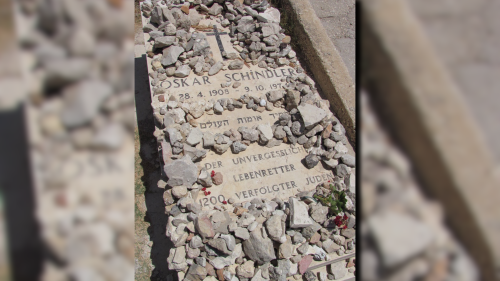If Fake News is a “threat to democracy,” what about Fake History? Although more subtle — Fake History is certainly much harder to expose than Fake News — the former is every bit as dangerous, if not more so.
Unlike the “news,” which is ephemeral, the presumed lessons of history are much more concrete and long-lasting. Take the historical writings of John Esposito, an award-winning professor of Islamic Studies at Georgetown University. He is the author of more 35 books on Islam; editor-in-chief of numerous Oxford reference works, including The Oxford Encyclopedia of the Modern Islamic World and The Oxford History of Islam; advisor to the award-winning PBS documentary Muhammad: Legacy of a Prophet (2002); and, perhaps most notably, a go-to expert on Islam, certainly in his heyday after 9/11, when he was frequently called on to brief the State Department, FBI, CIA, Department of Homeland Security and various branches of the military.
Clearly, such a man knows his Islam. (Incidentally, I was a graduate student at Georgetown University’s Center of Contemporary Arab Studies some 25 years ago, where he was treated like a celebrity whose word on Islam was law.)
But political correctness seems to be having the final say regarding Islam — even in his work.
The Claim
Let’s take a look at some of his words and see how accurate they are. Consider the following passage from Esposito’s book, Islam the Straight Path (p. 64):
Yes, you read that correctly. Esposito is saying is that, since Year One of the Islamic calendar (622 AD), to the First Crusade (1095), for nearly five centuries (473 years to be exact), Muslims and Christians lived in “peaceful coexistence.”
From 632 to 732, the newly founded Muslim state invaded and conquered three-quarters of the Christian world, including the Middle East and North Africa.
This claim obscenely ignores several cataclysmic and foundational events of world history. In just the first century following the death of Muhammad, from 632 to 732, the newly founded Muslim state invaded and conquered three-quarters of the Christian world, including the Middle East and North Africa , which was the older, richer, and more sophisticated part of Christendom. The Islamic jihad also conquered Spain and nearly France before it was finally halted in 732 at the Battle of Tours.
These conquests, like most, were bloody and savage. Contemporary sources, both Christian and Muslim, talk of the slaughter or enslavement of thousands upon thousands of Christians — the former lamenting the fact, the latter boasting. Perhaps most importantly, the sources — specifically the Muslim ones — make it unequivocally clear that all these atrocities were committed in the name of jihad: the reason Muslims were invading and conquering the lands of “infidels” was because Islam commanded it.
This was but the first of those “five centuries of peaceful coexistence” between Muslims and Christians before the First Crusade in 1095. There’s no room here to go over the other intervening centuries. In one year 1009 alone, Caliph Hakim bi-amr-Allah ordered the ritual destruction of 30,000 churches in Egypt and Syria — so let’s just fast-forward to the decades before the First Crusade.
“Mostly Peaceful”?
In 1019, “the first appearance of the bloodthirsty beasts … the savage nation of Turks entered Armenia … and mercilessly slaughtered the Christian faithful with the sword,” writes Matthew of Edessa, a chief contemporary source for this period (d.1144). In 1049, the Turks reached the unwalled city of Arzden and “put the whole town to the sword, causing severe slaughter, as many as one hundred and fifty thousand persons.”
Another eyewitness, Aristakes the Greek, notes that “without mercy, they [Turks] incinerated those who had hidden themselves in houses and churches.” Eight hundred oxen and 40 camels were required to cart out the vast plunder, mostly taken from Arzden’s churches — all 800 of which were afterwards ritually torched.
This was but the first of those “five centuries of peaceful coexistence” between Muslims and Christians before the First Crusade in 1095.
During the Turkish siege of Sebastia (modern-day Sivas) in 1060, 600 churches were destroyed and “many women and children were led into captivity.” Another raid on Armenian territory saw “many and innumerable people who were burned [to death].”
Between 1064 and 1065, Sultan Muhammad bin Dawud Chaghri — known among fawning Westerners as Alp Arslan, the “Brave Lion” — besieged Ani, the capital of Armenia. Once inside, the Turks “began to mercilessly slaughter the inhabitants of the entire city … and piling up their bodies one on top of the other…. Innumerable and countless boys with bright faces and pretty girls were carried off together with their mothers.”
Not only do several Christian sources document the sack of Armenia’s capital, so do Muslim ones, often in apocalyptic terms: “I wanted to enter the city and see it with my own eyes,” one Arab explained. “I tried to find a street without having to walk over the corpses. But that was impossible.”
Historic Atrocities
Nor was there much doubt concerning what fueled the Muslim Turks’ animus: “This nation of infidels comes against us because of our Christian faith and they are intent on destroying the ordinances of the worshippers of the cross and on exterminating the Christian faithful,” a man named David, who headed an Armenian region, explained to his countrymen in Matthew of Edessa’s account. Therefore, “it is fitting and right for all the faithful to go forth with their swords and to die for the Christian faith.” That they did — to no avail.
As the Turks moved further westward into Asia Minor, they visited the same atrocities on the Greeks of the Eastern Roman (or “Byzantine”) Empire.
Emperor Alexios I Komnenos summarized it in a letter to his friend, Count Robert of Flanders, who would become one of the first leaders of the crusade:
Fighting Back
And so, after the passage of nearly five centuries of this sort of “peaceful coexistence,” we at last come to the origins of the First Crusade. At the Council of Clermont in 1095 Pope Urban II told everyone in attendance what was happening to the Christians of the East:
At that point, all the knights in attendance cried Deus Vult — God wills it — and the First Crusade was off.
So now you know what really led directly to the First Crusade, which, in John Esposito’s make-believe world, sadly brought an end to “five centuries of peaceful coexistence” between Muslims and Christians.
Incidentally, the only time that Esposito alludes to the historic persecution of Christians by Muslims is by denying it. In regards to the knights crying, “Deus Vult,” for example, he writes, “This was ironic because, as one scholar has observed, ‘God may indeed have wished it, but there is certainly no evidence that the Christians of Jerusalem did, or that anything extraordinary was occurring to pilgrims there to prompt such a response at that moment in history.’”
The scholar that Esposito quotes is Francis E. Peters, in his essay, “Early Muslim Empires.” Clearly this academic is as delusional or dishonest as Esposito. To claim that nothing extraordinary was happening to Christian pilgrims is itself extraordinary. Here, for example, is what Michael the Syrian, a contemporary chronicler, wrote: (Note: I quote actual contemporaries and eyewitness to show what was happening then; Esposito quotes his colleagues.)
Such was the fate of one German pilgrimage to Jerusalem in 1064. According to one of the pilgrims:
So, there it is: the truth about John Esposito’s “five centuries of peaceful coexistence” between Muslims and Christians — until those evil European Christians spoiled it all by launching the First Crusade.
Now ask yourself this: If Esposito and so many other academics and “experts” who are regularly consulted about Islamic history can lie so flagrantly about an entire five centuries in an effort to blame Christians for initiating “bad blood” with Muslims, what else are they lying about when it comes to Islam’s relationship with the West?








